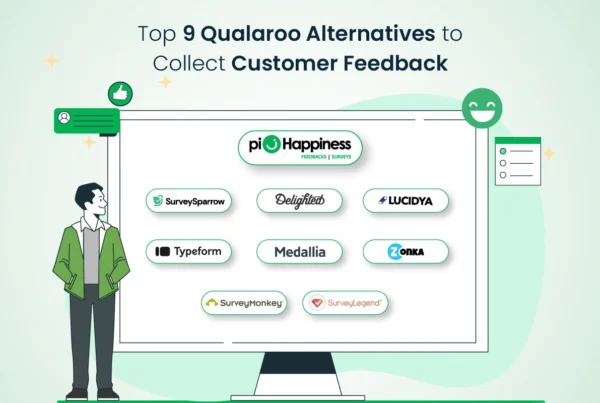An employee might exit an organization for many valid reasons, but catching up with the specific cause and understanding the employee narrative will drive the organization’s success moving forward.
However, if you can leverage these causes to your advantage, you may be able to retain other employees on board. An employee survey, particularly those conducted at the conclusion of employment, holds the power to enhance workplace culture and boost employee engagement.
If you strive to be an industry leader, retaining high performers should be your company’s priority. According to research, when a great deal of employees leave a company regularly (high turnover), the organization typically performs poorly. However, in contrast to its rivals, a company may have a significant advantage if fewer employees leave. This is particularly true if the company can retain its top employees.
In this blog, we will examine everything about how effective exit surveys can be.
The State of Exit Surveys: Are They Effective?
First, let’s define an exit survey:
Exit surveys are utilized to collect data from employees who willingly leave their current roles. The collected data focuses on why an employee quits an organization. It is said that employees are more inclined to express their honest opinions upon leaving.
Enhance retention with piHappiness exit surveys❤️
Keep your top talent and build a stronger team!
However, Harvard Business Review disagrees, claiming that employees are reluctant to inform their employers why they are leaving if the reason is negative since they need references. One way or another, employee exit surveys provide a clearer sense of “why” and “who.” Why—because the narrative behind departure and who—in some cases, might reveal the specific person or roles within the organizations influencing the decision to leave.
Ultimately, the effectiveness depends on the company’s approach to these surveys.
- Understand surface-level disparities: Employees from underrepresented departments might feel undervalued or unappreciated, and this could be a big reason why they leave a company—more so than other department employees.
- Improve Retention: By interviewing departing employees, you may be able to pinpoint the specific areas or issues within your company that are contributing to their exit, such as poor management or a lack of career advancement opportunities.
- Turn focus to strategic policies: Ask leaving employees what they feel about the organization’s main goals. For example, you could ask, “How do you feel about the training programs we offer? Do you think they help you learn and grow in your role?” This question will help you assess your company’s learning and development programs.
- Right data to upper management: Provide practical insights to your supervisors that may assist them in addressing and closing the gaps. For example, employees in tech departments report leaving the company because their skills are not being used appropriately. In that case, managers may alter their projects and duties to maximize the individuals’ skills.
Crafting the Right Exit Surveys
Define Your “why”
Start the employee survey without fluff by explaining why you are asking for employee feedback and how it will be used. It’s also important to let the departing employees know that being honest will not hurt their chances of receiving job references. Appreciate them beforehand for participating in the surveys and helping you identify areas for improvement.
An example of such an introduction may be: “We appreciate your input and promise to use it to improve our working environment. The purpose of this survey is to learn about your experiences and pinpoint areas that need work. Rest assured that your responses will be kept confidential and unaffected by them for any future employment references.”
By providing such concise and comforting introductions in your employee exit surveys, you may uphold trust with departing members and encourage them to offer open and helpful feedback.
Focus on Both Quantitative and Qualitative Data
Offer the opportunity to add their own remarks or respond to open-ended survey questions. This allows individuals to share more thorough ideas and suggestions.
- Open-ended Question: “What did you enjoy most about working here?”
- Comment Section: “Please share any further ideas or feedback you have regarding your experience with us.”
Including these questions and sections in the survey allows employees to express their thoughts freely, giving the organization vital acuities that multiple-choice questions may not reveal.
Pick a Theme
Picking a theme(s) in employee exit surveys may assist companies in understanding clearly why employees are leaving the organization. Pick a theme from the following to conduct an effective exit survey.
- Work Environment: Acquire knowledge about the social and physical features of the workplace. This contributes to improving and encouraging the workplace environment.
- Company Culture: Determine whether the company’s policies and principles meet employee expectations. This will promote a supportive and unified corporate culture.
- Team members and supervisors: Assess the level of collaboration and leadership. This may benefit team dynamics and managerial techniques.
- Pay and Benefits: Assess whether workers believe they are being paid properly and whether the perks are sufficient. This guarantees appealing and competitive benefits for employees.
- Work Satisfaction: Determine the general level of happiness among employees with their jobs. This aids in determining broad problems influencing worker morale.
- Reasons for Departure: Recognize the causes behind each employee’s departure decision. These reasons identify the precise issues that require attention.
Ask the Right Questions
You can tweak the questions below and fit them within your range of diverse survey questions.
- Do you believe that you were able to fulfill your responsibilities as “sales manager,” “network engineer,” “data analyst” “etc?”
- How satisfied were you with your job overall?
- What aspects of your job did you like the most?
- What aspects of your job did you dislike the most?
- What was the main factor in your decision to depart?
- Did you feel safe and comfortable at work?
- How happy were you with your compensation package?
- What were the most bothersome aspects of your job?
- How frequently did these challenges affect your work?
- How did you feel you fit into the business culture?
- Were there any policies or practices that you considered especially problematic?
- How would you rank your relationship with your supervisor?
- How well did you collaborate with your teammates?
- Were the perks and bonuses adequate for your needs?
Ask these questions so that you won’t have to lose top performers from your organization.
Utilize Technology to its Core
Well-designed digital platforms streamline the process and completely eliminate pen-and-paper feedback systems. These employee survey tools not only save time but also allow employees to be candid with their responses.
- Automated Excellence: Digital systems can also perform analysis functions such as tracking trends, comparing an employee feedback survey across departments or demographics, and interpreting complicated feelings stated in text responses. These tools clearly identify possible concerns within the organizational culture that require addressing.
- Effortless Feedback Collection: These features enable respondents to complete the survey at their leisure, giving them the space and freedom to provide candid feedback.
- Actionable Insights: By allowing anonymous responses through online surveys, you boost your chances of collecting unfiltered feedback on work-life balance issues or development opportunities that may be lacking inside the organization.
Final Thoughts
Skilled workers are assets for any organization and the main force driving organizational success. Learning why they want to stay or leave your organization can help you achieve ascendancy.
A well-considered exit survey has the potential to enhance leaders’ ability to listen, uncover organizational best practices, and draw attention to overlooked obstacles and prospects. By letting workers know that their opinions count, it can increase retention and encourage engagement.








